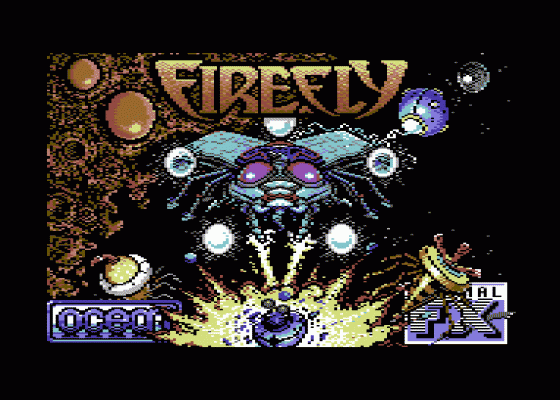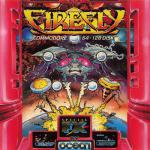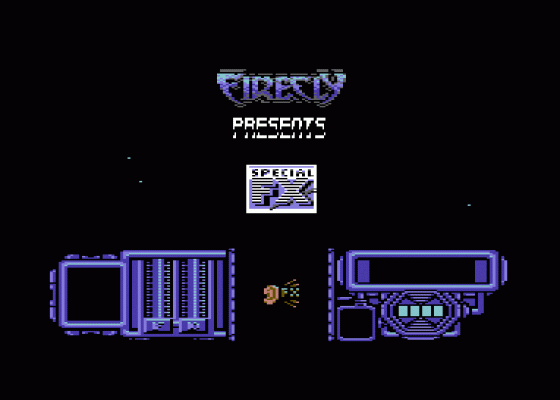Firefly
Returning to Earth after a decade of scientific research, the interstellar mothership Firefly discovers the Solar System is covered by a vast, chrome grid inhabited by Mechanoid dynasts. Adopting the role of Firefly commander, it's the player's task to destroy the enemy's grid system which contains their vital power source.
There are two basic screen displays: the Mechanoids' grid and the playing area of each sector. The grid consists of a combination of five types of area, each holding unique properties: robot-free 'Dead' Zones are in the player's control. Planetary Sectors are unbreachable and Robot Occupied Areas need to be deactivated. The System Power Source is the goal and usually the furthest point from the starting position, and there are also Unconstructed Regions (designated by arrows), where the player is launched into a sub-game, consisting of an alternating series of thumbs up or down. If the player presses fire on a thumbs-down, the grid is rearranged (sometimes with unfortunate consequences), and the Firefly is returned to the start. Thumbs-up results in the area being deactivated.
Entering a sector reveals an eight-way scrolling playing area with an information panel below. This displays a direction bar, current score, number of ships remaining, the number of energy units (or 'Yokas') collected, plus fuel and damage meters.

The ship is damaged by aliens and their missiles, incorrect teleportal operation, failure to overload the energy point or by entering the point with insufficient energy units; if the level reaches zero, a life is lost. However, the main function on the panel is the radar, upon which all major obstacles, teleports and energy points are shown.
Four energy points are destroyed to shut down the sector: these release 'Yokas', four of which are collected to allow access to a sub-game. This consists of two hands (thumbs up or down), which alternate at an increasingly rapid speed depending on the number already deactivated. Teleports obtain a similar sub-game, in which a light races around a circle of red and green dots; only three successive green contacts results in a successful teleport.
Shooting aliens with the Firefly's oct-o-phonic plasma disruptor balls results in deposits which are collected for occasionally favourable results. Additionally, predetermined objects are picked up to release droplets from the landscape which hold positive effects for the ship. When a sector is completed, the damage and fuel levels are replenished.
GH

As a concept, Firefly owes much to that other Ocean 'grid' game, Mutants, and a host of innovative features make it just as compulsive. Graphically, it's excellent: beautifully drawn, colourful and very detailed sectors offset nicely animated and individual sprites; only an occasionaly flickering mars the vibrant variety.
The sound echoes the high standard: despite the couple of derivative effects (Who Dares Wins grenade explosions), the overall atmosphere is superb: suitable bubbling, bouncing and buzzing noises assist a soundtrack which is genuinely good. Overall, the gameplay is attractive: the desire to deactivate the next sector and reach the Power Source is strong, the Unconstructed Zones, random location selection and sub-games all add spice.
Hyperactive on-screen sprites result in an often furious balance of blasting and collecting. However, there are two main objections: the luck element when shutting down the final energy point can be infuriating because it's such an integral part of the gameplay (although there's a way around it); similarly, having to completely clear a sector again when a life is lost is annoying.

However, set these minor irks aside and you have an innovative, compulsive and enjoyable game.
JR
I was instantly attracted by Firefly's excellent graphics and soundtrack, but as time went on, some very annoying quirks in the gameplay threw a wet blanket over my enthusiasm.
It all seems very exciting at first, but unfortunately the random element in the teleport and shut-down sub-games proves too much, especially since they form such an important crux in the gameplay - I'd much prefer that skill dictated progress, rather than an element of luck.

It's a shame that Firefly is so let down by such relatively inconsequential flaws. Still, ast least the overall slickness and superb presentation bode well for future Special FX productions.
PG
Having witnessed Firefly's good looks and great Fred Gray sounds from a distance, I was set for terrific game. On actually playing though, I found myself at the mercy of some awful reaction tests.
The main maze negotiation section is fine: it plays well and boasts some very nicely drawn and coloured graphics, with lots of variety and imagination in the shooting action.
Unfortunately, progress is only made through the grid if you can beat the 'Gamble' sub-games. While they aren't too bad at the beginning, after the third or fourth enegy unit it becomes a question of 'close your eyes and pray'. It may sound like a minor niggle but it's quite annoying to play such an otherwise well put together game only to have progress halted by a pair of minor subsections.
As it stands, Firefly is a game of luck and skill, with the priority of these requirements in that order.
Verdict
Presentation 79%
Informative instructions and clear screen display, but lacking in useful options such as a game save.
Graphics 84%
Bright, varied and detailed backdrops accompany a host of colourful sprites.
Sound 81%
Decent soundtrack, with varied and appropriately good in-game effects.
Hookability 82%
The grid system and random sector location make completing an area very compelling.
Lastability 68%
Plenty of sectors, graded difficulty and innovative features, but the interest may wane for some.
Overall 79%
A beautifully-presented and rewarding game marred by excessive emphasis on luck.


 1st April 1988
1st April 1988

